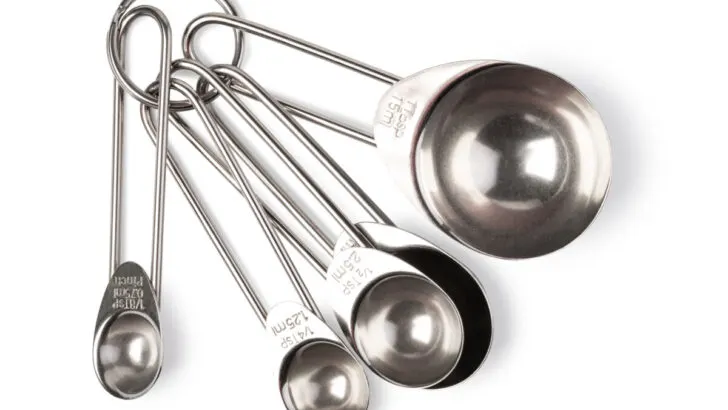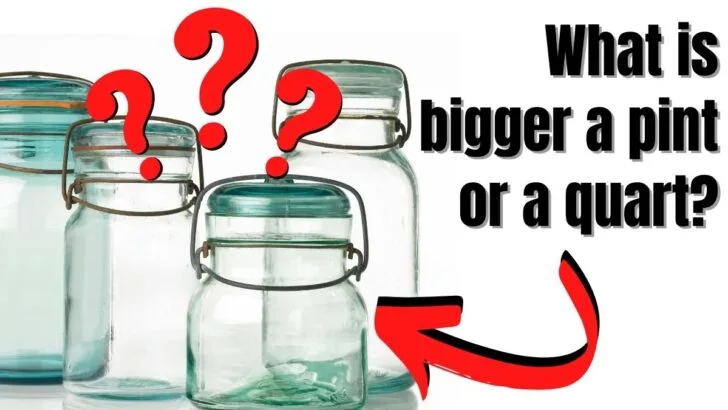Not everyone remembers how large quarts, pints, gallons, liters, or ounces are compared to each other. Is a pint bigger than a quart?
Quarts are bigger than pints, as a pint is only half a quart’s size.
A quart is 32 ounces, whereas a pint is only 16. Read on to learn more about sizes of measurements!
Is a Quart Bigger Than a Liter?
A US quart is a little bit smaller than a liter. A quart is 0.946 liters or 946.25 milliliters. Quarts fit evenly into US measurements like gallons but not into metric measurements.
If you have heard otherwise, you might be thinking of an imperial quart.
Imperial quarts were used in Britain in the past. However, they have been almost completely replaced by the metric system since then. Only US quarts, which are smaller than liters, are still used.
Quarts Compared to Cups
There are four cups in one US quart. A cup is equal to 236.58 milliliters and is half a pint or one-sixteenth of a gallon.
If you have heard that a cup is exactly 250 milliliters, that is a metric cup. A metric ton (1000 kilograms) is also different from a US ton (2000 pounds).
How Many Ounces Are In a Quart?
There are 32 fluid ounces in a quart or 16 in a pint. A fluid ounce is 1/128th of a gallon.
An “ounce” can mean a few different things. It can refer to a fluid ounce, a dry ounce, or an ounce of weight.

Are There Smaller Measurements Than Teaspoons?
Yes, there are smaller measurements than teaspoons in the US system. There are pinches (1/8th of a teaspoon), dashes (1/16 of a teaspoon), and drops (1/60 of a teaspoon).
A teaspoon is 4.93 milliliters, so a drop is less than a tenth of a milliliter. These measurements are still commonly used in recipes.
What Does a Quart of Water Weigh?
There is no real answer to a question like “How many pounds make up a gallon,” because a gallon of one liquid is heavier than a gallon of another. For example, a gallon of water will weigh differently than a gallon of milk.
However, you can measure how many pounds of water there are in a gallon, pint, or quart. A quart of water weighs 2.086 pounds, a gallon 8.35 pounds, and a pint 1.043 pounds.
Are Imperial Measurements the Same as US Measurements?
No, there’s a difference between an imperial and US quart. If you convert them both into metric units, an imperial quart is 1136.52 milliliters, and a US liquid quart is 946.35 milliliters.
Many other measurements are different between the two systems. The pint, ounce, and gallon are all different.
There is also a difference between a fluid gallon and a dry gallon, a fluid quart and a dry quart, ext in the US system.
For distance, there is no longer any difference between a US and a British yard. Before the mid-20th century, there were small differences in distance measurements.
Dry Quarts vs. Liquid Quarts
Dry quarts are bigger than liquid quarts and are bigger than liters. A dry quart is 1101 milliliters.
Just as there are four liquid quarts in a liquid gallon, there are four dry quarts in a dry gallon.
Precious Metal Weights
The measurements that people use for precious metals are not the same as for ordinary goods. When you measure silver or gold, you use troy ounces, which are not the same as regular ounces.
There is a difference between “avoirdupois weight” (regular measurements for regular goods) and troy weight for precious metals.
Weights for Medicines
Previously, medicines were measured using apothecaries’ weights, different from avoirdupois or troy weights.
However, medicines are now measured in metric in the United States. Doctors and scientists often used apothecaries' weights well into the 20th century, but the system is no longer used.
There Used to Be Hundreds of Measurements
If you go back far enough, there were hundreds of ways to measure distance, weight, and volume. Each country would have its own definition of the gallon, and there might even be a few different gallons in the same country.
These countless systems were abandoned over the decades and centuries. Today, only the metric system and the US system are commonly used.
Key Takeaways to Pints vs. Quarts
A quart is bigger than a pint and is equal to two pints. A quart is a quarter of a gallon. One quart equals two pints, 32 fluid ounces, 64 tablespoons, and 192 teaspoons.
A quart is a bit smaller than a liter as long as you mean a US quart. An imperial quart (no longer commonly used) is a bit more than a liter.
Practical Applications in Cooking and Baking
Understanding the difference between a quart and a pint is essential for cooking and baking.
Knowing how many pints are in a quart and how to convert measurements when scaling recipes is important.
Here are some practical applications of quart and pint measurements in cooking and baking.
Liquid Measurements
In cooking and baking, liquid measurements are crucial. A pint is equivalent to 2 cups, while a quart is equal to 4 cups.
When scaling recipes, it is important to know how many cups are in a pint or quart and how to convert them.
For example, if a recipe calls for 2 quarts of water, that would be 8 cups of water. Similarly, if a recipe calls for 1 pint of milk, that would be 2 cups of milk.
Dry Goods
When it comes to measuring dry goods like flour or sugar, a quart, and a pint are not interchangeable. A pint of flour is not the same as a pint of water because flour is denser than water.
One pint of flour weighs approximately 8 ounces, while one pint of water weighs 16 ounces. A quart of flour weighs approximately 32 ounces, while a quart of water weighs 64 ounces.
It is important to use a kitchen scale to measure dry goods accurately.
Oil and Other Liquids
When measuring oil or other liquids, it is important to note that a pint of oil weighs more than a pint of water. One pint of oil weighs approximately 16 ounces, while one pint of water weighs 16 ounces.
A quart of oil weighs approximately 32 ounces, while a quart of water weighs 64 ounces. When following a recipe, it is important to use the appropriate measuring cup for oil or other liquids.
Scaling Recipes
When scaling recipes, it is important to know how to convert measurements. For example, if a recipe calls for 2 cups of flour, and you want to make a larger batch, you can multiply the recipe by 2 to get 4 cups of flour.
Similarly, if a recipe calls for 1 pint of milk, and you want to make a smaller batch, you can divide the recipe by 2 to get 1/2 pint of milk.
Understanding Liquid and Dry Volume
When it comes to measuring volume, there are two main types of measurements: liquid and dry. Liquid volume is used for measuring liquids, while dry volume is used for measuring dry ingredients such as flour, sugar, and grains.
In the United States, the standard unit of liquid volume is the fluid ounce (fl oz), while the standard unit of dry volume is the quart. One quart is equal to 32 fluid ounces.
It’s important to note that liquid volume and dry volume are not interchangeable. For example, one quart of flour and one quart of water do not have the same volume. This is because dry ingredients can be compressed, while liquids cannot.
To make things even more confusing, there are different types of quarts and pints. The US customary system uses a different quart and pint than the imperial system used in the UK. In the US, one pint equals 2 cups or 16 fluid ounces, while one quart equals 2 pints or 32 fluid ounces.
It’s also worth noting that there are different sizes of measuring cups for liquid and dry ingredients. Liquid measuring cups have a spout and are designed to be filled to the brim, while dry measuring cups are designed to be filled to the top and then leveled off.
Pints and Quarts in Different Countries
Pint and quart are volume units used in different countries, and their size may vary depending on the country’s measurement system.
Here is a breakdown of how pints and quarts are measured in various countries:
United States
In the United States, the pint and quart are units of volume measurement in the US customary system. One US pint equals 16 fluid ounces, and one US quart equals 32 fluid ounces or two pints.
Australia
In Australia, the pint and quart are not commonly used units of volume measurement. The metric system is used in Australia, and the standard units of volume are liters and milliliters.
United Kingdom
The United Kingdom uses the imperial system of measurement, where one imperial pint is approximately 568 milliliters, and one imperial quart is equal to two pints or approximately 1.1 liters.
Canada
Canada mostly uses the metric system, although the imperial system is still used in some cases, including volume measurement.
One imperial pint equals 20 fluid ounces, and one imperial quart equals two pints or 40 fluid ounces.
Other Countries
Other countries, including those in Europe and Asia, use the metric system as their standard measurement system. However, some countries still use traditional units like pints and quarts, but their volume may vary according to regional custom.
In summary, the size of pints and quarts varies depending on the country’s measurement system.
The United States uses the US customary system, while the United Kingdom uses the imperial system. Australia uses the metric system, which is also used by most other countries worldwide.
Frequently Asked Questions
How many pints are in a quart?
There are two pints in a quart. This means that if you have a quart of milk, you can divide it into two equal parts to get two pints.
Is a pint larger than a cup?
Yes, a pint is larger than a cup. A pint contains 2 cups of liquid, while a cup contains only 1 cup of liquid.
Which is smaller, a cup or a pint?
A cup is smaller than a pint. A pint contains 2 cups of liquid, while a cup contains only 1 cup of liquid.
What is smaller than a pint?
A half-pint is smaller than a pint. A half-pint contains 1 cup of liquid, while a pint contains 2 cups of liquid.
How many cups are in a quart?
There are 4 cups in a quart. This means that if you have a quart of milk, you can divide it into four equal parts to get four cups.
Is 1 quart equal to 2 pints?
Yes, 1 quart is equal to 2 pints. This means that if you have a quart of milk, you can divide it into two equal parts to get two pints.


